The wines of Andrzej Greszta
The wines of Andrzej Greszta, Polish vintner on the Mosel and his incredible story.
The wines of Andrzej Greszta, Polish vintner on the Mosel and his incredible story.
Some nice festive drinking.
Pre-opening photos of the brand new Chopin Museum in Warsaw.
Two hundred years ago from today, a shy boy was born.
Black turnip – a great ancient vegetable. And the wines that go with it.
It’s hot…
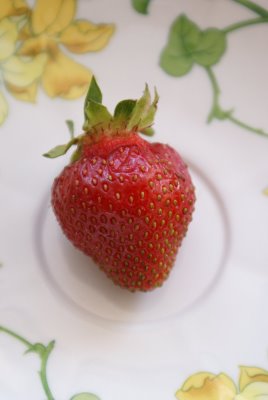
Poland is a strawberry empire, currently the 6th largest producer in the world and 2nd in the EU (after Spain). A large part of the production is processed into jam and other preserves and there’s a high chance your Bonne Maman confiture includes more than a fair share of Polish fruit.
But the major excitement is with the dessert strawberries. Starting with the second decade of May through about the current period in July you can buy fresh strawberries absolutely everywhere, from green markets to improvised stalls on the high street. They’re also ridiculously cheap (this year’s rate was 0.60€ / kg) and really, really delicious.
There are several factors that make Polish strawberries such a feat. They are predominantly grown by small and smallish farmers, avoiding the large-scale industrial conditions that they see in Spain (Poland and Spain together produce more than 60% of Europe’s crop). They are usually grown directly in the ground (industrial fruit is usually grown on plastic foilage or even more sophisticated devices such as high-trellised plastic tubes). I’ll be far from saying much of Polish strawberry is organically grown but they surely see less pest control and more rudimentary fertilisation than the mass-produced stuff. They’re also universally sold on the day of picking (or the morning after an evening harvest). Unlike Spanish or Chilean strawberries that keep for a week in the refrigerator, it’s best to eat them on the day.
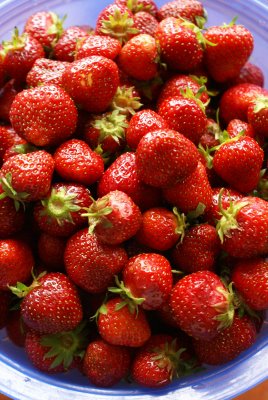
Polish strawberries are usually moderate in sweetness and have quite a crisp taste, especially early in the season. I usually enjoy the very first weeks best: that semi-sweet, crisp, subdued flavour is very refreshing. The intensity and depth of flavour is unmatched by any strawberry I’ve tried in Europe. They’re almost finished for this year, but when you’re planning your June holidays next year, you now know where to come: to Poland for strawberry tourism!
It’s also interesting to look at strawberries as a companion to various wines. When you serve them with sugar and Chantilly or in a tart, you’re restricted to fairly sweet dessert wines, but eaten on their own in the glory of their unadulterated natural flavour, there’s a broader range of possible pairings. Here I opened four different wines to have a look at strawberries and wine matching.
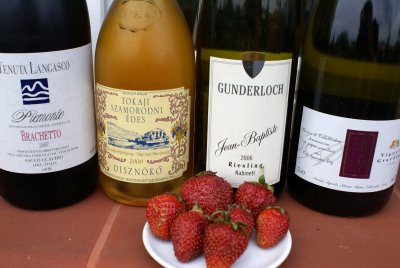
Adami Prosecco di Valdobbiadene Dry Vigneto Giardino 2006
A light, joyously frothy Italian fizz with a fair bit of residual sugar (‘dry’ is, in fact, a semi-sweet version). Notes of caster sugar and vanilla should be a natural match for strawberries. Yet the wine’s sweetness comes across as insufficient. Plus I’m not really convinced by the bubbles here: strawberries and fizz are an all-time classic for many people but for me, the slight coarseness and bitterness bubbles create on the palate tend to mask the natural fruit flavours. This was tried with not very sweet strawberries early in the season, and if you take sweeter fruit, it can be even more of a problem. It’s not a bad match all in all, but lacks sparkle to my tastes.
Tenuta Langasco Piemonte Brachetto 2007
This is a sparkling sweet red from Piedmont (similar to the Quagliano I reviewed
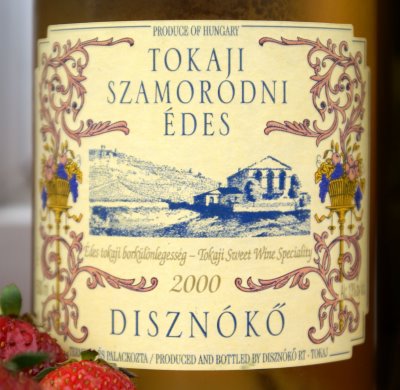
Conclusions? If you’re serving strawberries alongside biscuits or sponge cakes, a weighty sweet wine like the Tokaj I tried is a good all-rounder. For a luxurious apéritif, sweetish fizz is OK, provided it’s really fruity and intense. A Spätlese or light Auslese-styled Riesling is also a great idea, and this can be extended to other grapes such as Muscat or Pinot Gris. An intensely fruit semi-dry rosé could also work.
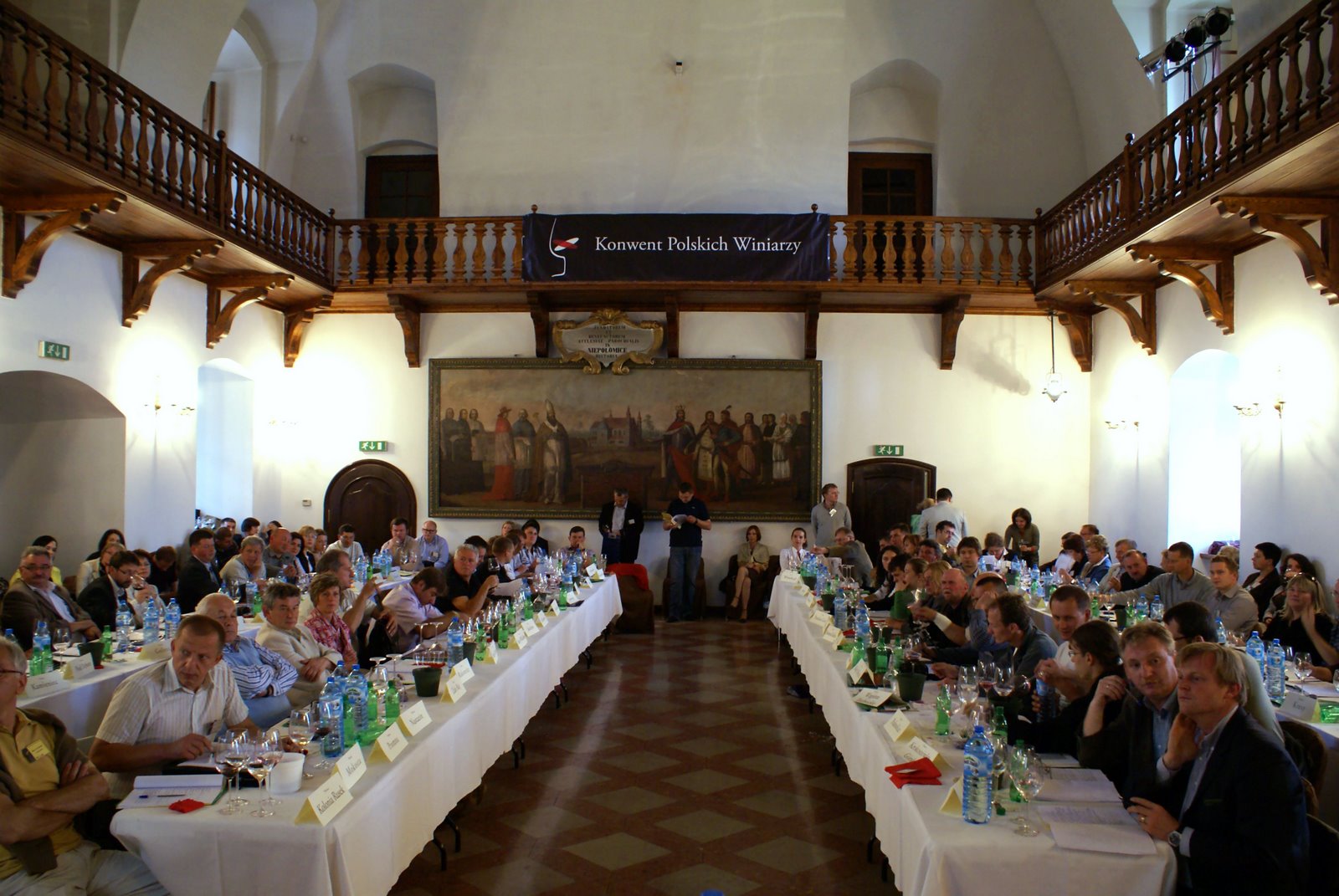 All these people are Polish vignerons.
All these people are Polish vignerons.
Polish grape wine is not available for purchase anywhere in the world and as such has a limited relevance to my dear readers, but judging by the number of visits forwarded by a ‘Polish wine’ Google search or similar, the curiosity is surely there. The subject is beyond the scope of this blog entry and I’ll be publishing a Polish wine primer on my main website soon; what follows is a summary.
You’ll be forgiven for not thinking of Poland as a wine country, as for the last centuries production was minimal and no permanent wine-producing tradition was established. The small vineyards around Zielona Góra (developed when this region belonged to Germany before 1945) and in Podolia bore wine almost exclusively for local consumption. All this changed in the last decade. With global warming, a growing wine market, and Homo sapiens’ incurable atavistic attraction towards growing grapes, Poland suddenly became a wine producing-country on a growing scale. When EU accession was negotiated Poland was included in ‘zone A’ countries with no cap set for future vineyard plantings. Today, we have more than 500 hectares, and this figure is growing by 15% every year.
Poland lies at the northern geographical limit for vine growing but with mean temperatures increasing in the last two decades and winters far less severe than they used to be, viticulture is now viable in a large part of the country. Naturally, vineyards are concentrated in the south with Subcarpathia, Lesser Poland and Lower Silesia each having around 25% of Poland’s acreage, but vineyards have been established as far north as Mazuria and Słupsk.
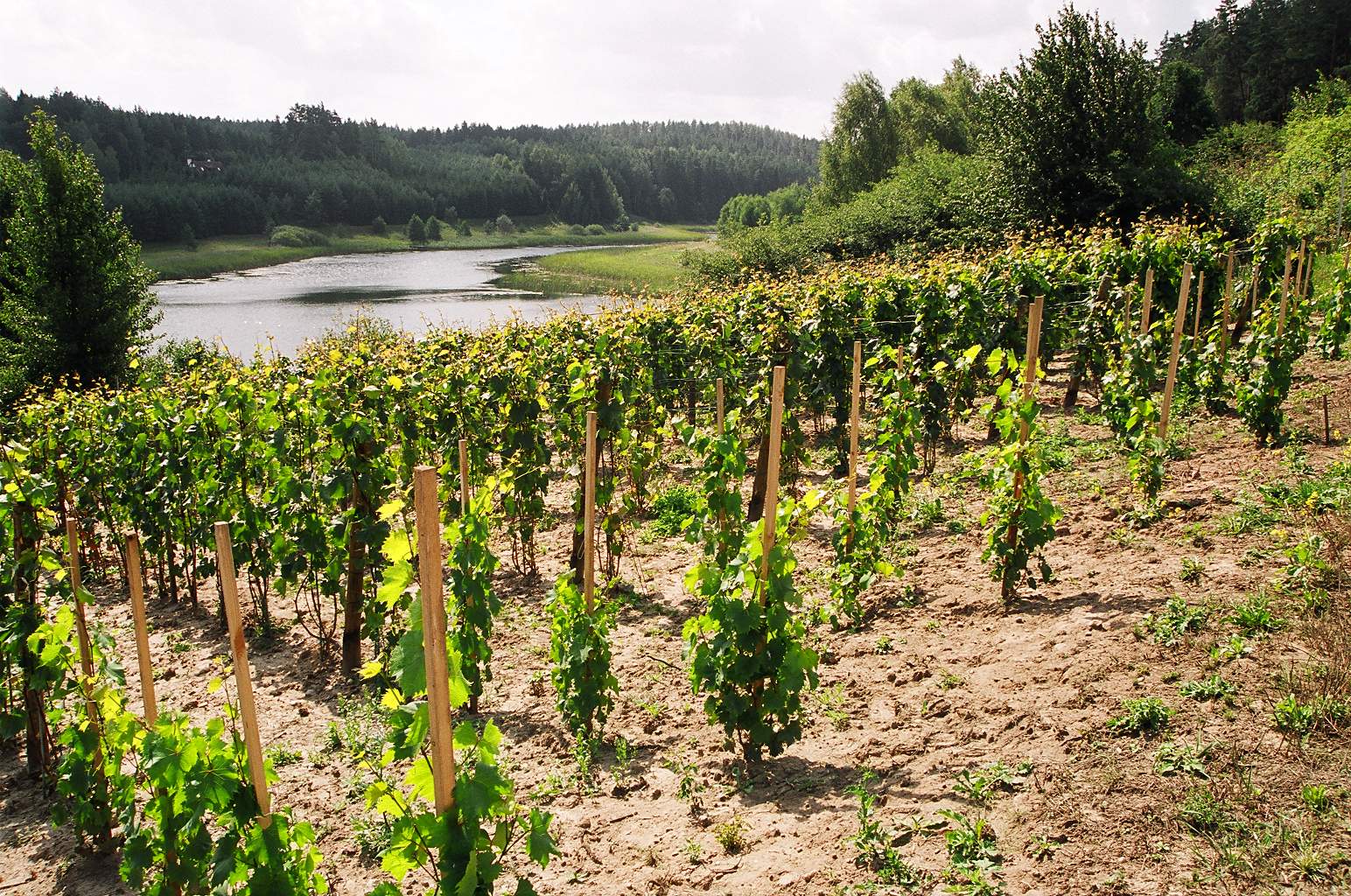
Vitis vinifera proper is and will in the foreseeable future remain a minority in Polish vineyards but is responsible for a good part of the better wines. Only the warmest terroirs can be successful, such as Lower Silesia and Zielona Góra where there is a pre-war tradition of vinifera plantings and even some recently recovered old local clones. Red grapes include Dornfelder, Zweigelt, Pinot Noir, Frühburgunder and even pockets of Cabernet Sauvignon, while among white varieties we have Pinot Gris and Pinot Blanc (the former with some potential), Riesling (perhaps some good wines in the future), Müller-Thurgau, Sauvignon and Grüner Veltliner. Stylistically these wines are similar to Saxony or England, though far less consistent.
Apart from the harsh climate, Polish wine still suffers from a very rudimentary winemaking technology and lack of experience. Only a few producers have transcended the ‘home-made wine’ stage to produce any quantity of technically correct, stable, drinkable wine. Many vintners are happy to make wine as an extra attraction on their agrotouristical farms. It will take a decade or two before substantial investment and education bring the general level of the wines up. In any case, at the time of writing only two of the 500 estimated wineries have officially released wine for sale: there is a cornucopia of insane sanitary and tax regulations that make it virtually impossible for a small agricultural estate to comply with the requirements and obtain permission for sale. Consequently there is no chance to see any wines exported in the near future. (And there would be no reason as the quantity is small enough to be entirely consumed by patriotic locals).
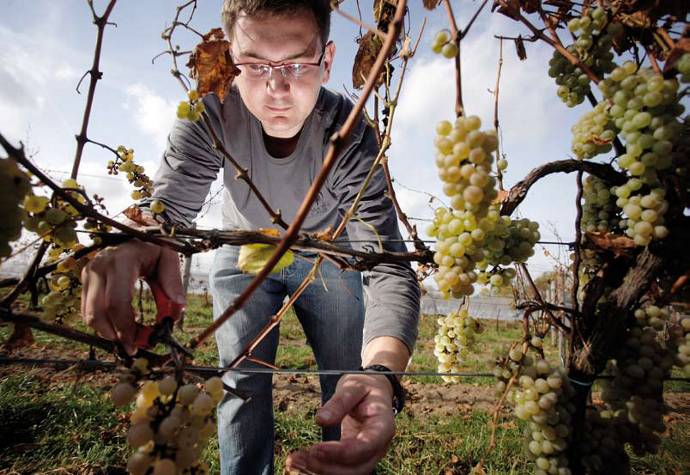
Winemaker Piotr Stopczyński (formerly at Diamond Oaks in California) in the vineyards of the Jaworek estate near Wrocław. © Tomasz Wałków.
During the 4th Polish Vintners Convention, we tasted over 70 wines from nearly 40 estates. The difficult 2008 vintage (very rainy autumn) influenced the quality heavily, and many wines suffered from dilution and unripeness, adding to the usual technical defaults such as overchaptalisation, oversulphuring, oxidation and instability at bottling. There were highlights, however, and for future reference you might want to remember such names as Winnica Płochockich (winnica = vineyard) with their good range of whites (including the delicious Seyval Blanc) and a recently introduced Zweigelt, and Winnica Pańska Góra with perhaps Poland’s most interesting terroir to date (bare limestone rock) and some exciting unchaptalised whites led by the Hanna blend. I’ll have more recommendations in the Polish wine primer on the main website soon. For the time being, some Polish wine label art appears below.
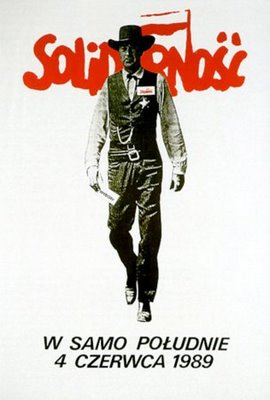
A famous 1989 poster by Tomasz Sarnecki.
Today’s a big day for Poland. Two decades ago, on Sunday 4th June 1989, the first free elections since World War II were held, resulting in a landmass victory for Solidarity and effectively putting the Communist regime to an end. Other countries of the ‘Eastern bloc’ followed suit. Five months later, the Berlin wall was demolished, and two years later, the USSR ceased to exist.
In this day of pride and satisfaction, we look back at that amazing summer of 1989 and what we’ve been able to achieve since. Among many far more serious things, we can enjoy a boundless diversity of wines, buy tea directly from Taiwan on the internet, develop private breweries and buy the latest music CDs in a range of high-street shops. Many things wouldn’t exist without Poles going to the polls two decades ago, including this blog.
Between 8 and 8:20pm today, all across Poland people raised a toast to our happy past and, hopefully, auspicious future. Chez Bońkowski, it seemed suitable to do so with a wine from our Slovenian brothers-in-freedom. The Dveri-Pax Eisenthür 2005 is a wine that couldn’t have happened two decades ago. Slovenia was still part of a country called Yugoslavia, where wine could only be bottled and sold by state-controlled cooperatives. Now this historical estate in Slovenian Styria (it was founded in the 12th century as a Benedictine abbey) has been reprivatised and with a large investment, vineyards have been renewed and a new state-of-the-art cellar established. The first wines were released in 2002 and Dveri-Pax quickly confirmed its rank as one of the leading wineries in Slovenia.
This 2005 Eisenthür single vineyard wine is a blend of 70% Sivi Pinot (local name for Pinot Gris) and 30% Šipon (local name for the Hungarian Furmint), and weighs in at 12.5%. A little capricious at first, it really gains from some airing, showing a very clean minerality from the strong volcanic terroir. It is quite Austrian in style (back in 2005 the winery’s consultant was Erich Krutzler from the famous red wine estate in Burgenland, now making wine at Weingut Pichler-Krutzler) with ripe green fruit and a clean, zesty style. It’s not a great wine, showing a bit of dilution and underripe greenness – but bear in mind 2005 was a fairly difficult vintage in this part of Europe, and the wine is fairly balanced with a good sense of place. Even its imperfections seemed to fit in today’s mood of Central European celebration.
This honey is typical of southern Poland highlands. Goldenrod being one of the last plants to bloom in the early fall, this honey is rarely sold (often being left for the bees to feed on during the winter). As many honeys it is renowned for its medicinal properties – for all ailments of the bladder, prostate, and kidney stones in this case.This specific goldenrod honey is from the
Intensity of flavour and length of aftertaste are, for me, the hallmarks of a truly great honey. This one is really excellent.